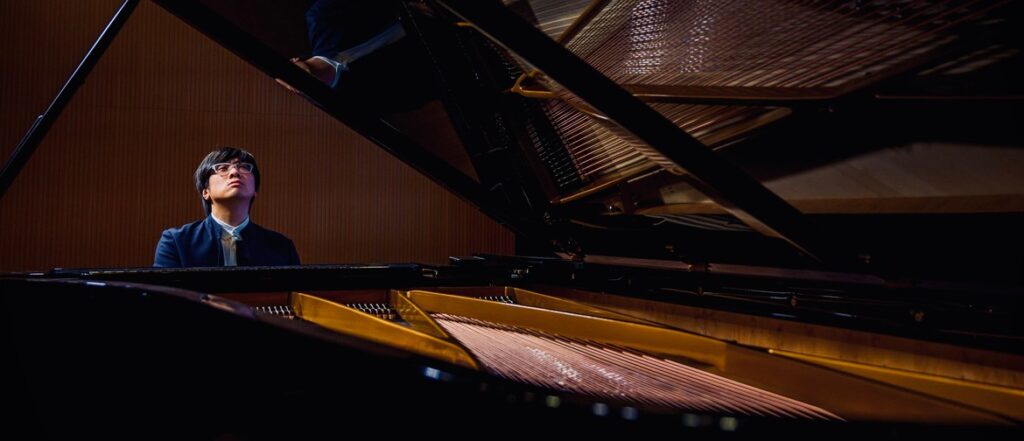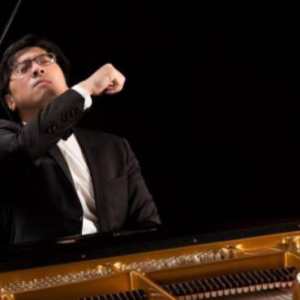 Quang Hong Luu
Quang Hong Luu
St.Andrew’s 2024 Lunchtime Concert Series presents:
QUANG HONG LUU (piano)
– a programme of 19th Century Romantic Piano Music
FRANZ LISZT – “Funérailles” from Harmonies Poétiques et Religieuses S.173
ROBERT SCHUMANN – Kinderscenen (Scenes from Childhood) Op.15
JOHANNES BRAHMS – Piano Sonata No. 3 in F Minor Op.5
St.Andrew’s-on-The-Terrace, Wellington
Thursday, 19th September, 2024
Vietnamese-born Quang Hong Luu began his early music studies in 1997 at the Vietnam National Academy of music in Ha Noi before completing a Bachelor of Music with Professor Kyunghee Lee at the Australian Academy of Music and Performing Arts, and going on to study his Masters degree at Montreal University in Canada with the great Đặng Thái Sơn, winner of the 1980 International Chopin Competition in Warsaw. He’s now in Wellington at Te Kōkī School of Music at Victoria University, pursuing his Doctorate of Music under the guidance of Dr. Jian Liu.
I unfortunately missed an earlier recital given by Quang at St. Andrew’s in June this year, at which he played the music of Debussy and Liszt, the latter a composer whose work Annees de Pelerinage (“Years of Pilgrimage”) is the research topic of Quang’s doctoral thesis. On that occasion he played the first of the work’s three “years” – the Premiere Annee: Suisse (“First Year: Switzerland”). This time round we were given a single-movement work of Liszt’s, Funérailles, taken from a different set of pieces, the Harmonies Poétiques et Religeuses. Quang’s recital was in fact a kind of “19thCentury Romantics” collection, which included works by Schumann and Brahms, all of which were connected with one another by subject, circumstance and personality.
In this programme’s case, however, the “chronology” of the individual pieces had to give way to temperament and circumstance. Had Quang begun the recital with the earliest of the three works, Robert Schumann’s enchanting Kinderscenen (in itself an attractive prospect), the arrangement would have then pitted two “heavyweight” pieces in a cheek-by-jowl confrontation, works moreover whose respective creators were fated, it seemed, to be at odds with each other right from the beginning of their short-lived association! Schumann’s work seemed, therefore, the perfect “rainbow bridge” by which both Quang Hong Luu and his audience could traverse the yawning gap between the worlds of Franz Liszt and Johannes Brahms.
So, the recital began with Liszt’s Funeráilles (“Funeral”) – a piece dated October 1849, though it related as much to the events of 1848 in Hungary, an uprising against Hapsburg rule that failed and resulted in the deaths or banishment of three of Liszt’s friends involved in the proceedings (one of these being the former Hungarian Prime Minister, Count Lajos Batthyány, executed in October 1849). No blacker nor more fraught and dread-laden sounds could have been conceived at the outset as Quang’s remorselessly-delivered opening bell-tones intensified the music’s menacing tread and gradually tightened its grip in an upward vortex of attenuated alarm. The sombre funeral-march that followed eventually emerged in the pianist’s hands as a tender, upwardly beseeching lagrimoso, before reaching a brief climax which prompted a passage as distinctive as that of Liszt’s great contemporary, Frederic Chopin in his famous Op.53 A-flat Polonaise’s depiction of “the thunderous hooves of the Polish Cavalry”, here as powerful, heroic and cataclysmic in itself up to its fortissimo peak.
 Quang Hong Luu
Quang Hong Luu
A furious flourish led to an angry restatement of part of the funeral march, Quang allowing a broken, haunted rendition of parts of the lagrimoso theme and a defiant restatement of the climax of the “thunderous hooves” section to at once “reawaken” and unify one’s sensibilities, a “wringing-out” of the emotions to devastating effect at the stark, muted end of the piece.
After such travails, how even more appropriate the insertion of Schumann’s “Kinderscenen” now seemed in the scheme of things! And its opening, with the perfectly suitable title Von fremden Ländern und Menschen (Of Foreign Lands and Peoples) seemed in itself to help reframe the experience of the Liszt work we had just heard to a kind of profound “imagining” – of course Schumann was at pains to emphasise that his pieces were impressions of an adult looing back on childhood, summed up at the end by the piece Der Dichter spricht (The Poet Speaks).
Quang’s playing was simple and unaffected at the outset, giving the brief hesitation of wonderment at each “rounding off” of the second subject its due without exaggeration. An eager and bright-eyed Curiose Geschichte (A curious story) tumbled into a vigorous Hasche-Mann (Catch me if you can), while the beautifully “echoed” phrasings of Bittendes Kind (Pleading child) found an almost Dickensian contrast in the following Glückes genug (happy enough). Quang maintained the pomp and ceremony of Wichtige Begebenheit (An Important Event) right through to the end, rather than observing a diminuendo leading towards the final chord, as some interpreters do, anticipating the onset of the contemplative (and justly-famous) Traumerei (Dreaming), its reprise here under Quang’s fingers especially tender.
A gentle awakening “at the Fireside” (Am Kamin) was followed by a roisterous Ritter vom Steckenpferd (Knight of the Hobbyhorse), whose exertions may have been too much of a good thing, leading as they did to the world of wonderment and anxiety in itself that Fast zu Ernst (Almost too serious) so touchingly portrayed, and even went on to suggest the presence of phantom-like shadows in the following Fürchtenmachen (Frightening). Quang allowed the first few measures of the following Kind im Einschlummern (Child falling asleep) to melt the E minor anxieties into a central major-key section of ravishing beauty, a magical transformation of time and consciousness becoming music. And magical, too, was the full-circle epilogue Der Dichter spricht (The poet speaks), the voice warm, dreamy, confiding, philosophical, at once confidential and candid, Quang sensitively evoking the composer’s voice recognising and paying retrospective homage to his own world.
Appropriately, the pianist left the platform for a moment, but was soon back with us, ready to once again “reimagine” with us the territory about to be explored via the last, and most epic of Johannes Brahms’s three sonatas for piano, the mighty Op. 5 in F Minor, a work amazingly wrought by a twenty year-old (surely among the most prodigious compositional feats of musical history!). Brahms took the work to Düsseldorf when first meeting Robert and Clara Schumann and presented it to the by-then-ailing Schumann, who nevertheless roused himself sufficiently to pen his famous “New Paths” article (his last) in his influential periodical “Neue Zeitschrift für Musik”, in which he heaped effusive praise on the embarrassed younger composer, writing of one who was “fated to give expression to the times in the highest and most ideal manner, who would achieve mastery, not step by step, but at once, springing like Minerva fully armed from the head of Jove. And now, here he is, a young fellow at whose cradle graces and heroes stood watch…..his name is Johannes Brahms….”
Quang Hong Luu’s attack at the Sonata’s beginning had everything, strength, power, focus and vigour, the music flung towards us unapologetically, with both ends of the keyboard activated in the manner born, and with the opening flourish countered by a louring, grimly-voiced theme underpinned by reminiscences of Beethoven’s “Fate” motive from his C Minor Symphony, and later a grandly lyrical theme whose extended variant climbed gloriously up the keyboard and proclaimed its majesty, before Quang reiterated the challenge and plunged the music into as combatative a development as one could imagine, the four-note Beethoven theme insistently underpinning the reiteration of the work’s opening. It was as visceral an encounter between elements of the classical sonata as could be imagined, evoking the same kind of titanic forces as those of Beethoven’s in his “Hammerklavier” Sonata.
Having spent his energies battling the forces of fate in this first movement, Brahms then evoked a different world of poetry and recaptured sentiment in a second movement, Andante expressivo, which pianist Claudio Arrau once described as “the most beautiful love music after Tristan”. Quang’s playing was gorgeously poetic and gently-flowing, the second episode in particular here made absolutely enchanting, with beautiful timing of those Schumannesque bass notes that seemed to conversely “float” the music in celestial waters, eventually reaching a magnificent climax whose depth of tone and variety of colour seemed positively orchestral in its impact. It was no wonder that Brahms seemed at the piece’s end to have difficulty in relinquishing his hold on such a spellbinding mood.
 Quang Hong Luu
Quang Hong Luu
Quang then tore into the Waltz-Scherzo movement with unbridled energies, more muscular and rapier-like in its cut-and-thrust than various heartier, more bucolic renditions I’ve heard. How beautiful and hymn-like, by contrast, was the Trio, still with an occasional Beethoven-motif presence, but stressing the song aspect over the dance for a few fleeting moments, even if the return of the scherzo’s main theme brought with it something more of a wild ride in Quang’s hands than a waltz-dance!
The Beethoven motif all but dominated the next movement, an Intermezzo with the title Rückblick (“Looking back”) something which obviously recalled the first movement’s Beethoven quote, though Quang’s voicing of it brought to my mind a reminiscence from another work, the slow movement of the “Tempest” Sonata, which Brahms would surely have known. And the frequent repetition of the opening ‘descending’ motif engendered something almost Faustian, its evocation of solitude and wandering from Part Two of Goethe’s work, a kind of “passage” towards a truly heroic final-movement scenario.
That’s what this last movement built up to from a series of brusque-sounding statements at its beginning, which Quang then contrasted with a beautifully-flowing-in-tempo major key sequence, before returning to the brusque opening, and ANOTHER beautifully contrasted rejoiner – this time, an even richer and nobler contrast, with characteristic Germanic woodland harmonic touches at the end – so nostalgic for all their fleeting quality. Quang then took up the composer’s invitation to pick up handfuls of the notes and run with them, whirling us through the excitement of, firstly an accelerando, and then a vertiginous coda which, after a few breathtaking moments solidly and heroically proclaimed the piece’s conclusion – what a work, and what a pianist!